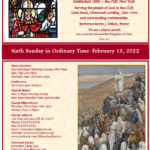This great apostle of Germany was born in England, between 672 and 680. When he was small, some missionaries stayed a while at his home. They told the boy all about their work and impressed Boniface because they were so happy and excited about bringing the Good News to people. Boniface decided in his heart that he would be just like them when he grew up. While still young, he went to a monastery school to be educated. Some years later, he became a popular teacher. When he was ordained a priest, he was a powerful preacher because he was so full of enthusiasm.
Boniface wanted everyone to have the opportunity to know about and love Jesus and his Church. He became a missionary to the western part of Germany. Pope St. Gregory II blessed him and sent him on this mission. Boniface preached with great success. Once, to prove that the pre-Christian gods were false, he did a bold thing. There was a certain huge oak tree the local people believed was sacred to their gods. In front of a large crowd, Boniface struck the tree with an axe. The big tree crashed. The people were enlightened when realized that their gods took no action against Boniface.
In his lifetime, Boniface converted great numbers of people. In place of the statues of the pagan gods, he built churches and monasteries. In 732, the new pope, St. Gregory III made Boniface an archbishop and gave him another mission territory, Bavaria. He and some companions went there to teach the people about Christianity.
Then, one day, he was preparing to confirm some converts. A group of armed inhabitants swooped down on the camp. Boniface would not let his companions defend him. “Our Lord tells us to repay evil with good,” he said. “The day has come for which I have waited so long. Trust in God and he will save us.” The warriors attacked, and Boniface was the first one killed. He died a martyr on June 5, 754. His wish, stated in his will, that he be buried at the famous monastery he had started at Fulda, Germany were carried out.
Did St. Boniface invent the Christmas Tree?
The specific origin of the Christmas tree is lost in the distant past. It may have started when pre-Christian rituals involving evergreen boughs were merged with Christian celebrations and beliefs.
It seems to be generally recognized that the people who lived in what is now Germany were the first to develop the tradition of the Christmas tree. One tradition is that when Boniface cut down the famous oak tree that he was surprised to find a fir tree growing in its place. The fir was thereafter associated with the primacy of the Christian faith.
Martin Luther is credited with first placing candles on the Christmas tree. He spent a great deal of time walking through the forests of evergreen conifers thinking through his beliefs. The candles are said to have represented the stars he saw through the trees.









Speak Your Mind